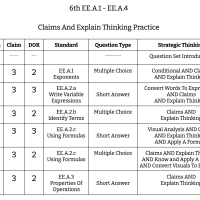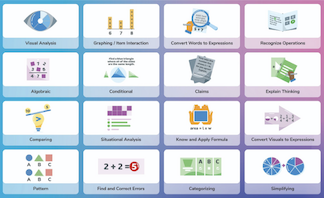
6th Grade Math - Expressions And Equations - EE.A.1 to EE.A.4 - Claims and Explain Thinking Practice
7 Questions
6th Grade Math - Expressions And Equations - EE.A.1 to EE.A.4 - Claims AND Explain Thinking Introduction
Audrey was asked to create an expression that uses three terms, involving exponents, that produces a sum of exactly 100. Her expression is shown below.
Henrietta claims that the correct expression to solve the problem below is 4(4) - 15 = c. Do you support her claim? Why or why not? Type in your answer.
Support or dispute the student's claim in the information below and explain.
Stefan claims that he was running at a rate of exactly five miles per hour. Look at the data below. Do you support his claim? Why or why not? Type in your answer.
The square below has a side length of 2x + 1.
Casey argues that (x - y) will always equal (y - x) due to the Commutative Property of Subtraction. Do you agree with Casey? Why or why not?

We help districts in California boost CAASPP Math Scores by Δ +20% by helping teachers determine if students are struggling with the content, the technology involved with the type of question, or the type of strategic thinking required. Based on the 8 Standards for Mathematical Practice, our platform and professional development empowers teachers to recognize all 16 types of strategic thinking across any math question, curriculum, or assessment.
Learn more